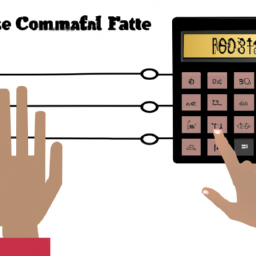Interest is the cost of borrowing money, and it can either be simple or compound. Simple interest is only based on the principal amount of a loan, while compound interest is based on the principal and accumulated interest. Understanding the difference between these two types of interest is essential when borrowing or saving money.
A simple interest calculator can help you find the amount of interest your savings account, bond, or CD could earn over time. It is a useful tool for comparing different investment options and determining which one is best for you. To use a simple interest calculator, you need to know the principal amount, interest rate, and the length of time you plan to save or invest.
For example, let's say you have $10,000 in a savings account that earns 1% simple interest per year. After one year, you would earn $100 in interest, and your total balance would be $10,100. If you keep your money in the account for another year, you would earn another $100 in interest, and your balance would be $10,200.
On the other hand, compound interest is when the interest you earn on a balance in a savings or investing account is reinvested, earning you more interest. The longer you leave your money in the account, the more interest you earn. A compound interest calculator can help you determine how much money your savings can earn over time.
To use a compound interest calculator, you need to know the initial investment amount, the interest rate, the number of years you plan to save or invest, and the compounding frequency. Compounding frequency refers to how often the interest is compounded, such as monthly, quarterly, or annually.
For instance, if you invest $10,000 in a savings account that earns 1% compound interest per year, compounded annually, after one year, you would earn $100 in interest. Your total balance would be $10,100. If you leave that money in the account for another year, you would earn interest on the initial $10,000 investment plus the $100 in interest earned the first year, resulting in a total balance of $10,201.
Understanding how interest is charged on loans is also essential. Here are the main differences between simple interest and compound interest. Simple interest is a fixed charge based on loan principal, and it's typically assigned as a percentage. It's a way of calculating how much you'll pay in interest over time. In contrast, compound interest is interest charged on both the principal and accumulated interest, resulting in a higher total interest payment over time.
To decide which type of CD is best for you, consider its value. Here's how to calculate how much money you'll earn in interest when you invest in a CD. First, determine the principal amount you plan to invest, the interest rate, and the length of the CD term. For example, if you invest $10,000 in a CD that earns 2% simple interest per year for two years, you would earn $400 in interest, resulting in a total balance of $10,400.
In conclusion, using a simple interest calculator or a compound interest calculator can help you make informed decisions about your savings and investment options. It's essential to understand the difference between simple and compound interest and how they can affect your finances over time. By using these calculators and comparing different investment options, you can make the most of your money and achieve your financial goals.
Ticker: N/A
